UTC Fire and Security Americas CO915FFH Carbon Monoxide Alarm User Manual TX 6310 01 1 Carbon Monoxide Alarm Manual
UTC Fire & Security Americas Corporation Carbon Monoxide Alarm TX 6310 01 1 Carbon Monoxide Alarm Manual
User Manual
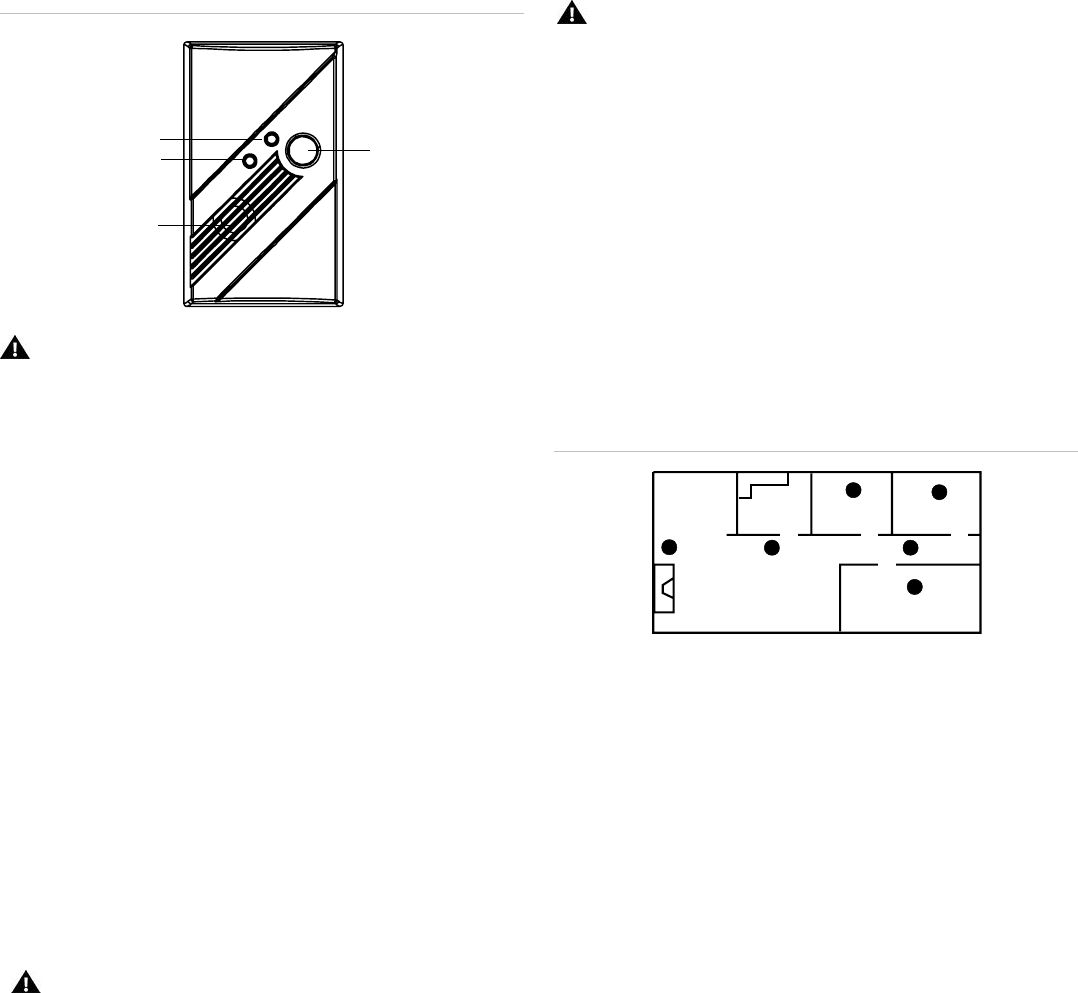
1 / 8 2533-7222-00
263A-CO-OEM-ATT01
Carbon Monoxide Detector
Figure 1: Detector features
WARNING: This detector should be installed by a
certified technician.
Attention: Please take a few minutes to thoroughly read this
user guide which should be saved for future reference and
passed on to any subsequent owner.
Description
The 263A-CO-OEM-ATT01 wireless carbon monoxide (CO)
detector monitors the levels of CO gas and gives early warning
when potentially dangerous levels exist. It does not detect fire,
smoke, or any other gas. If a dangerous concentration of CO is
detected by the patented and field-proven electrochemical
sensor, an LED indicator illuminates and an internal siren is
activated in temporal 4 pattern. The CO detector also transmits
an alarm signal to the control panel within 15 seconds of
detecting dangerous concentration of CO gas. The control panel
activates its internal siren and reports the detector condition to
the central monitoring station. The CO detector also detects low
battery, wall tamper, and detector end-of-life. These trouble
codes are transmitted to the control panel. The detector
automatically resets when CO is no longer detected.
The 263A-CO-OEM-ATT01 wireless CO Detector is certified to
the ANSI/UL2075 standard for CO detectors. It is intended for
residential indoor dwelling unit applications. It is not intended for
use in industrial applications.
WARNING: After ten years from initial power up, this
detector will beep two times every 30 seconds to indicate that it
is time to replace the detector. Replace the detector immediately!
It will not detect CO in this condition.
To help identify the date to replace the detector, an area has
been reserved on the side of the detector. Write the “replace by”
date (ten years from power up) with a permanent marker in the
area provided.
WARNING: Installation of this CO detector is not a
substitute for proper installation, use, and maintenance of fuel
burning appliances including appropriate ventilation and exhaust
systems.
Detector location
CO detectors should be mounted in or near bedrooms and living
areas. We recommend that you install a detector on each level of
your home.
When choosing your installation locations, make sure you can
hear the detector from all sleeping areas. If you install only one
CO detector in your home, install it near bedrooms, not in the
basement or furnace room.
Place the detector out of reach of children. Under no
circumstances should children be allowed to handle the CO
detector.
Figure 2: Recommended locations
Locations to avoid
Improper location can affect the sensitive electronic components
in this detector. To avoid causing damage to the unit, to provide
optimum performance, and to prevent unnecessary nuisance
detectors:
• Do not install in kitchens, garages, or furnace rooms that
may expose the sensor to substances that could damage or
contaminate it.
• Do not install in areas where the temperature is colder than
40°F (4.4°C) or hotter than 100°F (37.8°C) such as crawl
spaces, attics, porches, and garages.
• Do not install within 5 ft. of heating or cooking appliances.
(We recommend 15 ft. to prevent nuisance alarms.)
• Do not install near vents, flues, chimneys, or any
forced/unforced air ventilation openings.
• Do not install on metal surfaces.
• Avoid mounting in areas with a large quantity of metal or
electrical wires.
• Do not install near ceiling fans, doors, windows, or areas
directly exposed to the weather.
• Do not install in dead air spaces, such as peaks of vaulted
ceilings or gabled roofs, where CO may not reach the
sensor in time to provide early warning.
Test/Hush button
Alarm sounder
Green Power LED
Red Alarm LED
Dining Kitchen Bedroom Bedroom
Bedroom
Living room
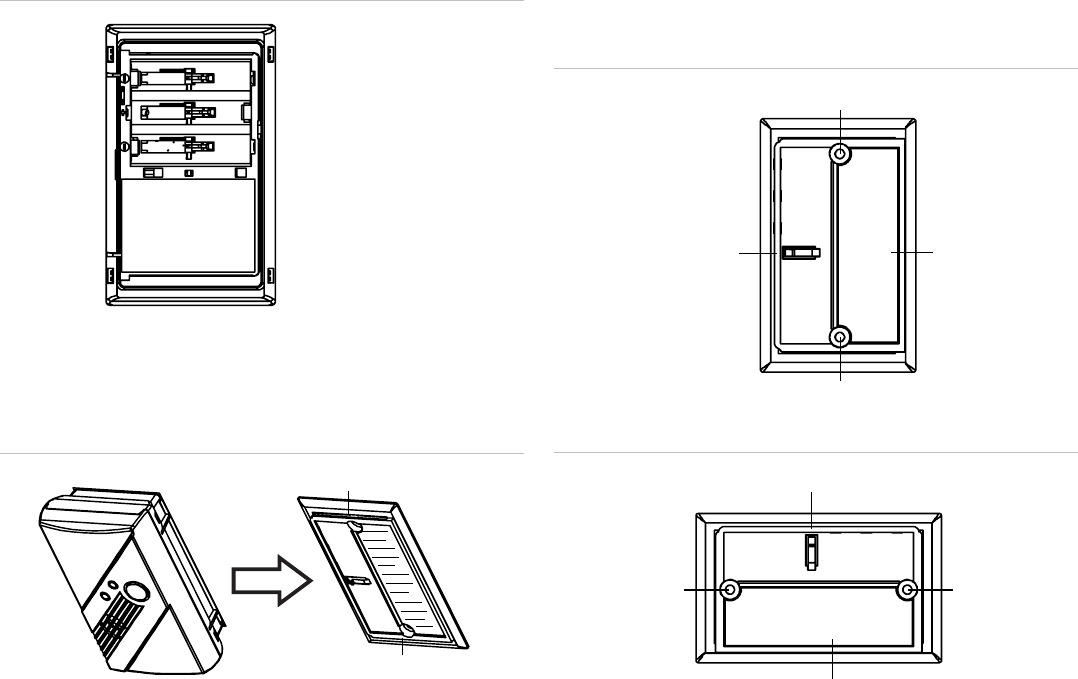
2 / 8 2533-7222-00
• Do not install near deep-cell large batteries. Large batteries
have emissions that can cause the alarm to perform at less
than optimum performance.
• Do not obstruct the vents located on the detector. Do not
place the detector where drapes, furniture, or other objects
block the flow of air to the vents.
• Do not install directly above sink. Do not install in a damp or
humid location or in the immediate vicinity of a cooking
appliance.
Battery installation and replacement
Note: Place the control panel into sensor test mode prior to
replacing the batteries. If the control panel is not in sensor test
mode during battery replacement, an alarm/tamper condition
may be indicated.
To install or replace the batteries in this detector:
1. Slide the detector body off of the mounting plate.
2. If replacing batteries, remove the old batteries and properly
dispose of them as recommended by the battery
manufacturer.
3. Install the new batteries. Note the polarity illustration in the
battery compartment (see Figure 3 below).
Figure 3: Batteries
4. Slide the body back onto the mounting plate.
Note: The mounting plate will not close if all three batteries
are not installed.
Figure 4: Sliding the detector on the mounting plate
5. Perform a sensor/RF test with the control panel. See “RF
communication test” on page 3
When replacing the batteries, use the following approved brand:
• Duracell MN1500
• Energizer E91
Note: Replacement batteries can be purchased at your local
hardware store.
Use of a different battery may have a detrimental effect on the
detector operation.
Note: Do not use lithium batteries in this unit.
Note: Constant exposures to high or low humidity may reduce
battery life.
After installing or changing the batteries, reinstall your detector.
Test your detector by using the Test/Hush button and check that
the green Power LED is on.
Mounting the detector
Note: Verify RF performance prior to permanently mounting the
detector. See “RF communication test” on page 3.
The CO detector can be wall mounted or ceiling mounted.
To mount the detector:
1. Slide the body off of the mounting plate. Place the mounting
plate in the desired location, and mark the location of the
two mounting holes. Orient the mounting plate vertically or
horizontally as shown in the following figures.
Figure 5: Vertical mounting
Figure 6: Horizontal mounting
2. Insert the two screws provided and secure the mounting
plate to the wall or ceiling surface.
W
ARNING XXXXXXXXXXXXXXXXXXX
XXXXXXXXXXXXXXXXXXXXXXXXXXX
XXXXXXXXXXXXXXXXXXXXXXXXXXX
XXXXXXXXXXXXXXXXXXXXXXXXXXX
Battery compartment
_
+
_
Alarm mounting guide
Alarm mounting guide
Mounting hole
Mounting latch Alarm
procedure
label
Warning
XXXXxx XXX x xxx
XX XXXXXXXxxx
XXXXXXX XXXxx
XXXXXXXX XX xx
XXXXxx XXX x xx
XX XXXXXXX xx
XXXXXXX XXXxx
XXXXXXXX XX xx
XXXXxx XXX xxx
XXXXXXXXXxx
XXXXXXX XXXx
XXXXXXXX XX
XXXXxx XXX xxx
XX XXXXXXX xx
XXXXXXX X X
XXXXXXXX XXxx
xxxxxxxxxxx
XXXXxxx
xxxxxxxxxxx
Mounting hole
Mounting
hole
Mounting
hole
Mounting latch
Alarm procedure label
Warning
XXXXxx XXX x xxx
XXXXXXXXXxxx
XXXXXXX XXXxx
XXXXXXXX XX xx
XXXXxx XXX x xx
XXXXXXXXX xx
XXXXXXX XXXxx
XXXXXXXX XX xx
XXXXxx XXX xxx
XXXXXXXXXxx
XXXXXXX XXXx
XXXXXXXX XX
XXXXxx XXX xxx
XXXXXXXXX xx
XXXXXXX X X
XXXXXXXX XXxx
xxxxxxxxxxx
XXXXxxx
xxxxxxxxxxx

2533-7222-00 3 / 8
3. After the mounting plate is secured, slide the detector over
the mounting plate (see Figure 4 on page 2).
Important labels provided
Two labels have been provided that have important information
on what to do in case of an alarm. Add the phone number of your
emergency service provider in the space provided. Place one
label next to the detector after it is mounted, and one label near
a fresh air source such as a door or window.
Programming
The following section provides a general guideline for
programming (learning) the unit into control panel memory. Refer
to the panel documentation for complete programming details.
To add the CO detector to panel memory:
1. Set the panel to program mode.
2. Proceed to the Learn/Add Sensors menu.
3. Select the desired sensor number.
4. Push the “Learn” button on the RF Module (within the
detector) using the provided tool to initiate enrollment. The
access hole is on the side of the detector.
5. When the panel prompts you for sensor group number,
enter the appropriate group number based on the system
panel.
6. At the panel, exit program mode.
Note: Each CO detector is programmed with a unique ID when
manufactured. The unique ID is enrolled into the control panel at
the time of installation, allowing the CO detector to communicate
with that specific control panel.
Testing
Note: This unit is sealed. The cover is not removable.
WARNING: The control panel must be placed into sensor
test mode while conducting any tests. Placing the control panel
into sensor test mode for all testing helps to protect against false
alarms and unintentional central station reporting.
Due to the loudness of the detector, we suggest that you place
your fingers over the sounder vent while testing your detector.
Caution: Continuous exposure to the high sound level of
this detector over an extended period of time may cause hearing
loss.
The CO detector provides three test modes:
• Normal CO detector test. Conducts an internal self-test
and tests the sounder.
• RF communication test. Tests the communication path
with the control panel.
• CO sensor functional gas test. Tests the functional
operation of the CO sensing element.
Normal CO detector test
1. Wait at least 10 minutes after installation to test the CO
detector.
2. Make sure the green Power LED is flashing for normal
operation.
3. Set the control panel to sensor test mode.
4. Press and hold the Test/Hush button until the unit beeps two
times (approximately 5 seconds), and then release the
button. If the unit is operating properly, you will hear four
quick beeps, followed by 5 seconds of silence, followed by
four quick beeps. The “TEST” and “ALARM” messages will
be sent to panel.
5. At the control panel, exit sensor test mode.
RF communication test
This section provides general guidelines for testing the CO
detector with the panel. Refer to the specific panel
documentation for complete testing details.
Before testing, ensure that your control panel is set to sensor
test mode. Setting your panel to sensor test mode prevents an
alarm signal from being transmitted to the central monitoring
station (if you have a monitored system).
1. Wait at least 10 minutes after installation to test the CO
detector.
2. Make sure the green Power LED is flashing for normal
operation.
3. Set the control panel to sensor test mode.
4. Press and hold the Test/Hush button until the unit beeps
once (approximately 1 second), and then release the button.
If the unit is operating properly, you will hear four quick
beeps. The “TEST” message will be sent to panel.
5. The control panel will beep and display the number of RF
packets received.
6. At the panel, exit sensor test mode.
CO inspection and functional gas test
A canned CO testing agent must be used for the CO functional
gas test. Contact local supplier for canned CO gas – solo C6 or
equivalent.
1. Wait at least 10 minutes after installation to test the CO
detector.
2. Make sure the green Power LED is flashing for normal
operation.
3. Set the control panel to sensor test mode.
4. Press and hold the Test/Hush button until the unit beeps
three times (approximately 10 seconds), and then release
the button. The unit will enter the functional gas test mode.
The Power LED will blink once per second while in
functional test mode.
5. Apply a CO test agent to the slit as shown in Figure 7.
When CO is detected, the unit will activate a CO alarm. The
unit will send RF test packets to the control panel when the
CO alarm is activated.
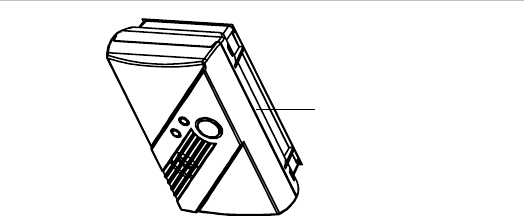
4 / 8 2533-7222-00
Figure 7: CO testing slit
6. The control panel will beep and display the number of RF
packets received.
7. At the control panel, exit sensor test mode.
8. Exit functional gas test mode:
Press and release the Test/Hush button; or a 2 minute
timeout will automatically cause the unit to return to normal
operating mode.
Troubleshooting
This information is provided to help you diagnose and solve
various problems that may arise while configuring or using the
wireless CO detector.
Unit does not power up properly or reports low battery:
• Make sure the batteries are fully seated within the battery
compartment and the polarity is correct.
• Make sure that all three batteries are installed.
• Check the battery voltage (1.5 VDC nominal per battery).
Control panel does not respond:
• Move or rotate the CO detector position.
• Make sure the CO detector is properly enrolled into the
control panel.
• Make sure that you are using a compatible control panel
(see Specifications ” on page 5).
Tamper condition does not restore:
• Make sure the CO detector body is properly installed on the
mounting plate.
• Make sure there are no trouble indications at the CO
detector.
If a tamper condition occurs:
• Make sure that the control panel is in sensor test mode
during detector testing.
Detector/open condition does not restore:
• Make sure that the CO detector condition has cleared at the
CO sensor.
CO testing slit
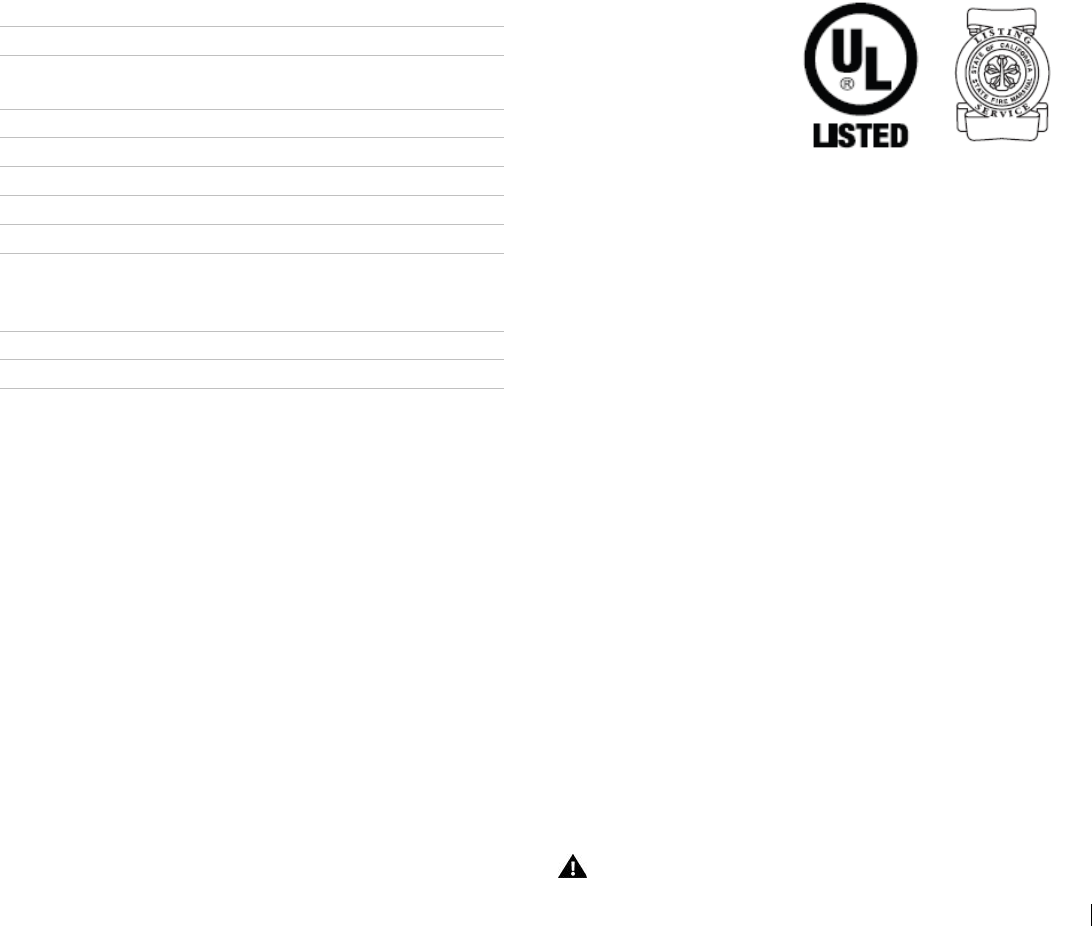
2533-7222-00 5 / 8
Specifications
Power
Three AA batteries
Battery type
1.5 VDC alkaline
Required batteries
Duracell MN1500
Energizer E91
Sensor
Electrochemical
Type
B
Battery Life
1 Year (minimum)
Detector life
10 years
Audible detector
Temporal 4
Detector response
times
70 PPM = 60-240 min.
150 PPM = 10-50 min.
400 PPM = 4-15 min.
Dimensions
4.68 x 2.75 x 1.85 in. (119 x 70 x 47 mm)
Storage temperature
-4 to 140oF (- 20 to 60oC)
Operating environment
Temperature
Relative humidity
40 to 100oF (4.4 to 37.8oC)
10 to 95% noncondensing
Regulatory information
Agency Rating
ANSI/UL2075, CSFM
Manufacturing information
Manufactured by:
Kidde Safety UTC CCS
4820 Centennial Blvd., Suite 145
Colorado Springs, CO 80919
FCC Compliance
FCC ID: QPY-CO915FFH
IC: 8303B-CO915FFH
The device complies with part 15 of the FCC Rules as well as
Industry Canada Rules and Regulations license-exempt RSS
standard(s). Operation is subject to the following two conditions:
(1) This device may not cause harmful interference, and (2) this
device must accept any interference received, including
interference that may cause undesired operation.
Le présent appareil est conforme aux CNR d'Industrie Canada
applicables aux appareils radio exempts de licence.
L'exploitation est autorisée aux deux conditions suivantes : (1)
l'appareil ne doit pas produire de brouillage, et (2) l'utilisateur de
l'appareil doit accepter tout brouillage radioélectrique subi,
même si le brouillage est susceptible d'en compromettre le
fonctionnement.
WARNING: Any changes or modifications made to this
product not expressly authorized by the manufacturer could void
the user’s right to operate this device.

6 / 8 2533-7222-00
Operation characteristics
Table 1: Operation characteristics
LED Display
Detector sound
Unit status
Control panel status
Recommendation
Normal operation
Green Power
LED flashes
every 30
seconds.
None.
Normal DC
operation (sensing
no CO) and with
good batteries.
Normal operating
condition.
None.
Carbon monoxide
alarm
Red Detector
LED flashes
with beeps.
Four quick beeps,
5 seconds
silence,
repeating.
Alarm condition.
Dangerous
concentrations of
CO detected.
Alarm condition.
See “Emergency Actions” on page 7.
Low battery /
low battery hush
Red Detector
LED flashes
every 60
seconds.
One quick beep
every 60
seconds.
Batteries need to be
replaced.
Trouble condition,
trouble beeps every 60
seconds.
Replace all three AA batteries.
Press Test/Hush button and release.
This will silence the low battery audible
chirp between 8 and 11 hours allowing
for a more convenient time to replace
the batteries.
Detector end-of-
life indicator/
end-of-life hush
Red Detector
LED flashes
two times every
30 seconds.
Two quick beeps
every 30
seconds.
End of CO detector
life.
Trouble condition,
trouble beeps every 60
seconds.
Press the Test/Hush button and
release. This will silence the end-of-life
signal for up to three days. After three
days, the unit will resume end-of-life
chirps. Hush mode will silence the
detector ten times or up to 30 days.
After 30 days, the unit can no longer be
hushed. Replace the CO detector
immediately. The unit will not respond
to CO.
Trouble/service
condition
Red Detector
LED flashes
every 30
seconds.
One quick beep
every 30
seconds.
Unit is in trouble
condition.
Trouble condition,
trouble beeps every 60
seconds.
Replace batteries. If condition
continues, unit has malfunctioned.
Replace immediately. Unit will not
respond to CO.
Error condition
Red Detector
LED constantly
on.
Constant alarm.
Very low battery or
unit malfunction.
Trouble condition,
trouble beeps every 60
seconds.
Replace batteries. If condition
continues, unit has malfunctioned.
Replace immediately. Unit will not
respond to CO.
Test mode
Red Detector
LED flashes
with beeps.
Four quick beeps,
5 seconds
silence, repeated
once.
Normal operation
when Test/Hush
button is pressed.
Sensor test mode
CO not detected. Alarm for test
purposes only.
Tamper
Red Detector
LED flashes
every 30
seconds.
One quick beep
every 30
seconds.
Unit is in tamper
condition.
Trouble condition,
trouble beeps every 60
seconds.
Place detector body back onto
mounting plate. If condition continues,
unit has malfunctioned. Replace
immediately.
Maintenance tips
To keep your detector in good working order:
• Perform a CO detector test once a week (see “Normal CO
detector test” on page 3).
• Vacuum the detector cover once a month to remove
accumulated dust.
• Never use detergents or solvents to clean the detector.
Chemicals can permanently damage or temporarily
contaminate the detector.
• Avoid spraying air fresheners, hair spray, paint, or other
aerosols near the detector.
• Do not paint the detector. Paint will seal the vents and
interfere with proper sensor operation.
Move the CO detector to a remote location, to prevent possible
damage or contamination of the sensor, prior to performing any
of the following:
• Staining or stripping floors or furniture, painting or wall-
papering.
• Using aerosols or adhesives.
WARNING: Reinstall the CO detector as soon as possible
to assure continuous protection.
The following is a list of substances that at high levels can
damage the CO sensor or cause temporary readings that are
not CO readings:
Ethylene, ethanol, alcohol, iso-propanol, benzene, toluene,
ethyl acetate, hydrogen, hydrogen sulfide, and sulfur dioxide.
Also most aerosol sprays, alcohol-based products, paint,
thinner, solvent, adhesive, hair spray, after shave, perfume,
auto exhaust (cold start), and some cleaning agents.

2533-7222-00 7 / 8
Information about carbon monoxide:
Carbon monoxide is a colorless, odorless, and tasteless poison
gas that can be fatal when inhaled. CO inhibits the blood’s
capacity to carry oxygen.
Periodically review this detector user guide and discuss your
CO Alarm emergency procedure with all members of your
family. Never ignore a CO Alarm. A true alarm is an indication
of potentially dangerous levels of CO. CO detectors are
designed to alert you to the presence of CO before an
emergency - before most people would experience symptoms
of CO poisoning, giving you time to resolve the problem calmly.
Determine if anyone in the household is experiencing
symptoms of CO poisoning. Many cases of reported CO
poisoning indicate that while victims are aware they are not
well, they become so disoriented they are unable to save
themselves either by exiting the building or calling for
assistance. Also, young children and household pets may be
the first affected. You should take extra precautions to protect
high-risk persons from CO exposure because they may
experience ill effects from CO at levels that would not ordinarily
affect a healthy adult.
Symptoms of CO poisoning
The following common symptoms are related to CO poisoning
and should be discussed with ALL members of the household:
• Mild exposure = Slight headache, nausea, vomiting,
fatigue (often described as “flu-like” symptoms).
• Medium exposure = Severe throbbing headache,
drowsiness, confusion, fast heart rate.
• Extreme exposure = Unconsciousness, convulsions,
cardio-respiratory failure, death.
If you experience even mild symptoms of CO poisoning,
consult your doctor immediately.
Conditions that can produce carbon
monoxide
Excessive spillage or reverse venting of fuel burning
appliances caused by:
• Outdoor ambient conditions such as wind direction and/or
velocity, including high gusts of wind; heavy air in the vent
pipes (cold/humid air with extended periods between
cycles).
• Negative pressure differential resulting from the use of
exhaust fans.
• Simultaneous operation of several fuel burning appliances
competing for limited internal air.
• Vent pipe connection vibrating loose from clothes dryers,
furnaces, or water heaters.
• Obstructions in or unconventional vent pipe designs which
amplify the above situations.
• Extended operation of unvented fuel burning devices
(range, oven, fireplace, etc.).
• Temperature inversions which can trap exhaust gasses
near the ground.
• Car idling
What CO detectors can and cannot do
CO Alarms provide early warning of the presence of CO,
usually before a healthy adult would experience symptoms.
This early warning is possible however, only if your CO
detector is located, installed, and maintained as described in
this user guide.
Because carbon monoxide is a cumulative poison, long-term
exposures to low levels may cause symptoms, as well as
short-term exposures to high levels. This unit has a time-
weighted alarm; the higher the level of CO present, the sooner
the alarm will be triggered.
This CO detector can only warn you of the presence of CO. It
does not prevent CO from occurring, nor can it solve an
existing CO problem. If your unit has alarmed and you’ve
provided ventilation by leaving your windows and doors open,
the CO buildup may have dissipated by the time help responds.
Although your problem may appear to be temporarily solved, it
is crucial that the source of the CO is determined and that the
appropriate repairs are made.
CO detectors have limitation. Like any other electronic device,
CO detectors are not fool-proof. CO detectors have a limited
operational life. You must test your CO detector weekly,
because it could fail to operate at any time.
If your CO detector fails to test properly, or if its self-diagnostic
test reveals a malfunction, immediately have the unit replaced.
This detector will not monitor CO levels while in a trouble
condition.
Caution: This CO detector can only sense CO that
reaches the unit’s sensor. It is possible that CO may be
present in other areas without reaching the detector. The rate
and ability with which CO reaches the detector may be affected
by:
• Doors or other obstructions.
• Fresh air from a vent, an open window, or other source.
• Fresh air from a vent, an open window, or other source.
• CO being present on one level of the home and not
reaching a CO detector installed on a different level. (For
example, CO in the basement may not reach a detector on
the second level, near the bedrooms).
For these reasons, we recommend you provide complete
coverage by placing a CO Detector on every level of the home.
CO Detectors should not be used to detect the presence of
natural gas (methane), propane, butane, or other combustible
fuels.
Instruct children never to touch or otherwise interfere with the
alarm. Warn children of the dangers of CO poisoning.
Important warning statements
This CO detector is designed to detect carbon monoxide from
ANY source of combustion. It is NOT designed to detect
smoke, fire, or any other gas.
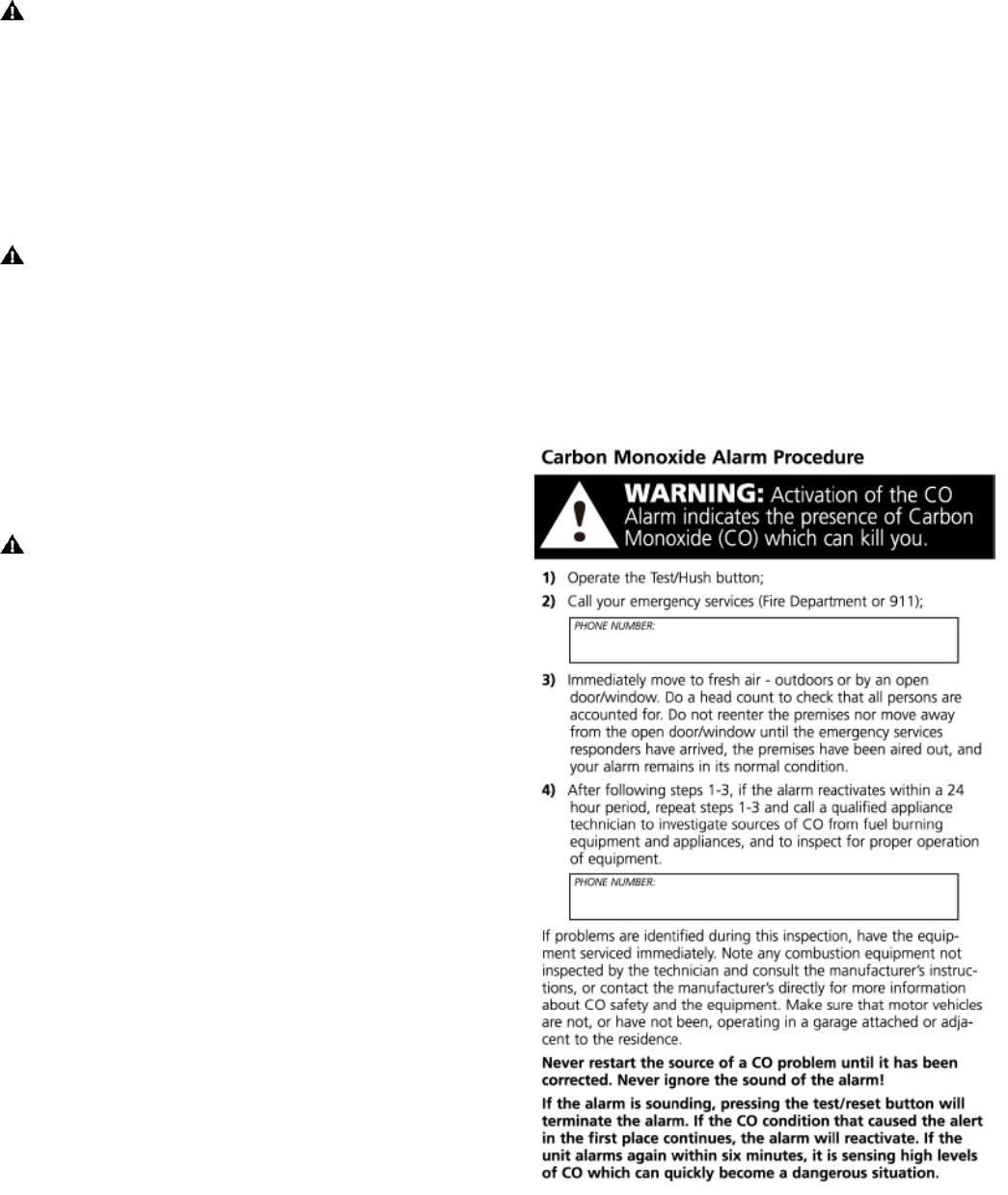
8 / 8 2533-7222-00
WARNING: Carbon Monoxide detectors are not
smoke alarms. This carbon monoxide detector is not a
substitute for installing and maintaining an appropriate
number of smoke alarms in your home. This CO
Detector will not sense smoke, fire, or any poisonous
gas other than carbon monoxide even though carbon
monoxide can be generated by fire. For this reason you
must install smoke alarms to provide early warning of fire
and to protect you and your family from fire and its
related hazards.
WARNING: This product is intended for use in
ordinary indoor locations of family living units. It is not
designed to measure compliance with Occupational
Safety and Health Administration (OSHA), commercial,
or industrial standards. It is not suitable for installation in
hazardous locations as defined in the National Electric
Code. The installation of this device should not be used
as a substitute for proper installation, use and
maintenance of fuel burning appliances, including
appropriate ventilation and exhaust systems. It does not
prevent CO from occurring, nor can it solve an existing
CO problem.
WARNING: This device is designed to protect
individuals from acute effects of carbon monoxide
exposure. It may not fully safeguard individuals with
specific medical conditions. If in doubt, consult a medical
practitioner. Individuals with medical problems may
consider using warning devices which provide audible
and visual signals for carbon monoxide concentrations
under 30 PPM.
This Carbon Monoxide detector requires a continuous
supply of electrical power - it will not work without power.
This CO Detector has not been investigated for carbon
monoxide detection below 70 PPM.
Limited Warranty
AT&T Digital Life Complete Protection - AT&T Digital Life
Complete Protection protects the Digital Life Equipment
(“Equipment”) that you bought from AT&T.
Complete Protection Period - Complete Protection begins on
the date Your Digital Life Equipment is installed and continues
for as long as you have the monthly service and are in good
standing.
What Is Covered - AT&T will repair or replace Equipment that
fails to operate as a result of defects in workmanship and/or
materials including electrical failure caused by a direct result of
a power surge. The Equipment must be purchased from AT&T
or from an AT&T authorized location. Equipment means the
Digital Life equipment you purchased from AT&T that connects
and is made a part of the AT&T Digital Life system. Equipment
will be replaced with those of like kind and quality, and may be
new or remanufactured. In most instances, AT&T, who will pay
shipping costs, will require you to return your defective
Equipment. Complete Protection does not change your original
equipment manufacturer’s warranty which remains in effect.
For all product returns, including warranty repair/replacements,
non-warranty repairs, advance replacements and credit returns
call AT&T at 1-855-288-2727.
Return units to: AT&T
13500 Independence Pkwy.
Fort Worth, TX. 76117
A note should be included advising the nature of the
malfunction. Care must be exercised in the proper packing of
detectors returned under this warranty as AT&T will not be
responsible for warranty repairs to equipment damaged
because of improper packing.
No agent, employee or representative of the Manufacturer nor
any other person is authorized to modify this warranty in any
respect. Repair or replacement as stated above is the
exclusive remedy of the purchase hereunder. This warranty
gives you specific legal rights and you also have other rights
which vary from state to state.